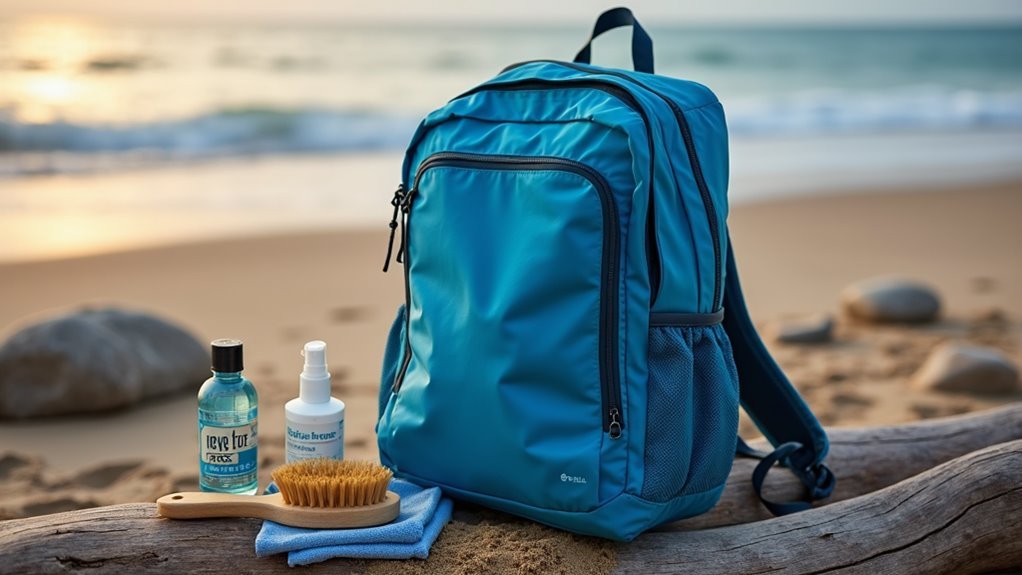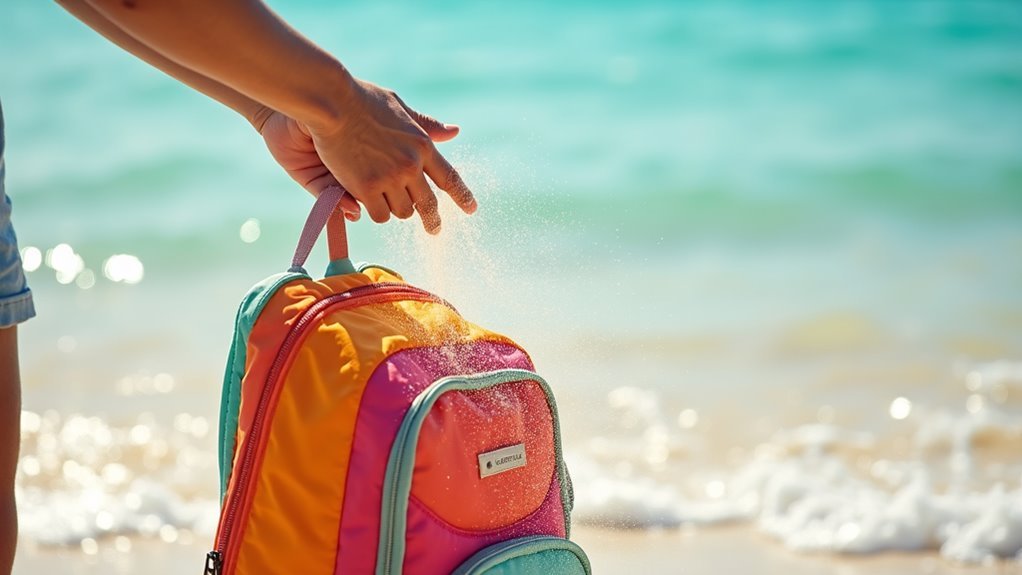I’ve found that emptying every pocket after each beach trip and giving my backpack a quick rinse with fresh water makes a huge difference. The salt residue is perhaps the biggest threat—I always wipe it down immediately and let everything air dry completely before storing. A soft brush helps with stubborn sand, and I think applying waterproofing spray to zippers extends their life considerably. These simple habits have kept my gear going strong for years, and there’s more you can do.
Essential Cleaning Techniques for Beach Backpacks

After spending countless beach days watching my gear get coated in sand and salt, I’ve learned that proper cleaning makes all the difference in keeping a beach backpack functional.
I always empty everything first—you’d be surprised what accumulates in those pockets.
A damp cloth works well for the exterior, though I sometimes use a soft brush for stubborn grime.
The interior needs vacuuming to remove sand particles. I think washing with mild detergent and warm water helps, but perhaps the most essential step is letting it air dry completely.
Rushing this part has backfired on me before.
Protecting Your Backpack From Sun and Salt Damage
While cleaning tackles the immediate mess, protecting your backpack from sun and salt damage requires a more proactive approach—something I wish I’d understood earlier. Those UV rays don’t just fade colors; they actually weaken the fabric fibers over time.
I’ve learned to wipe down saltwater immediately—it’s surprisingly corrosive if left sitting. A waterproofing spray on straps and zippers helps, though I’ll admit I forget this step sometimes.
Perhaps the simplest protection is just avoiding direct sunlight when possible. An umbrella provides decent coverage, and storing your pack in shade makes a real difference in longevity.
Proper Sand Removal and Saltwater Treatment

Sand gets everywhere—I mean absolutely everywhere—and I’ve probably spent more time than I’d like to admit trying to dig it out of every zipper and pocket after beach trips.
| Problem | Solution | Why It Works |
|---|---|---|
| Stuck sand | Shake vigorously first | Gravity does most work |
| Salt residue | Fresh water rinse | Prevents fabric breakdown |
| Stubborn grime | Mild detergent scrub | Removes without damage |
I think the key is acting fast—perhaps within hours of getting home. Salt’s particularly sneaky because it looks harmless but corrodes zippers and weakens fabric over time. I’ve learned to rinse everything immediately, even if I’m tired from the beach.
Long-Term Storage Best Practices
Once your beach season wraps up, proper storage becomes essential—though I’ll admit I didn’t always realize this until I pulled out a musty, mildewed backpack the following summer.
First, I clean off every grain of sand and bit of debris.
Then I’m careful around zippers while wiping everything down.
Pay special attention to zipper areas when cleaning—salt and sand love to hide in these spots and can cause serious damage over time.
Perhaps most importantly, I return all adjustable straps to their original positions to prevent stretching during months of storage.
Complete air drying is vital before tucking it away.
I think this step prevents that awful mustiness that ruins the excitement of planning your first beach trip.
Frequently Asked Questions
How Often Should I Replace My Beach Backpack’s Waterproofing Spray?
I’d recommend reapplying waterproofing spray to your beach backpack every 3-4 months or after heavy use. You’ll notice when water stops beading off the fabric – that’s your cue to refresh the protection.
Can I Machine Wash My Beach Backpack or Only Hand Wash?
I’d recommend hand washing your beach backpack instead of machine washing. The agitation can damage zippers, straps, and waterproof coatings. You’ll get better results using mild detergent, warm water, and gentle scrubbing.
What’s the Best Way to Repair Small Tears in Waterproof Fabric?
Your backpack’s practically screaming for freedom from those tears! I’d patch small rips with waterproof repair tape or seam sealer, applying gentle pressure. For bigger tears, I’d use iron-on patches designed specifically for waterproof materials.
Should I Treat Different Backpack Materials Like Canvas Versus Nylon Differently?
Yes, I’d definitely treat them differently. Canvas needs gentler cleaning with mild soap since it’s more absorbent, while nylon handles stronger detergents better and dries faster after your beach adventures.
How Do I Prevent Zippers From Getting Stuck With Sand Buildup?
I’ve discovered that rinsing zippers with fresh water immediately after beach trips prevents sand from hardening inside the teeth. You’ll want to gently work the zipper while rinsing to flush out stubborn particles completely.
Conclusion
Your beach backpack doesn’t have to become another summer casualty. By cleaning it regularly, protecting it from harsh elements, removing sand properly, and storing it correctly, you’ll avoid those frustrating end-of-season replacements. I think these simple steps make all the difference – though honestly, I wish I’d learned them sooner. Perhaps you’ll have better luck than I did with my first few bags. Take care of your gear, and it’ll take care of your beach adventures.